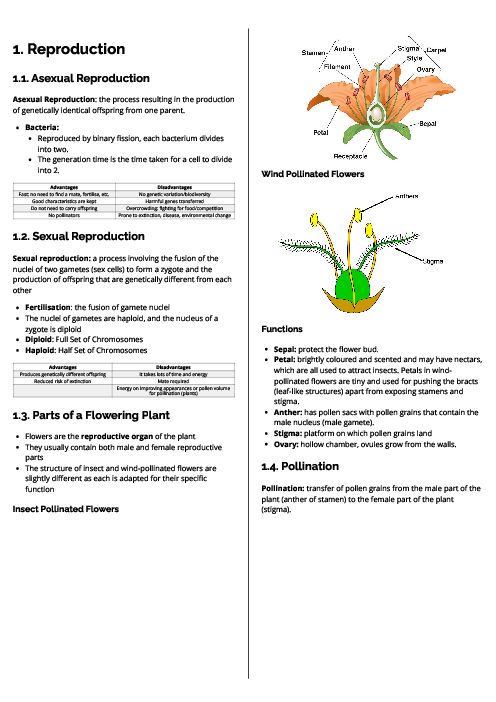Biology (0610) Reproduction Revision Note
Hestia Laurent
This document explains reproduction in plants and humans for CAIE IGCSE Biology. It begins with asexual reproduction, where one parent produces genetically identical offspring, such as bacteria through binary fission. Advantages include speed and preservation of traits, while disadvantages include lack of variation and vulnerability to disease. Sexual reproduction is described as the fusion of gametes to form a diploid zygote, producing genetically diverse offspring. The structure of flowering plants is outlined, comparing insect- and wind-pollinated flowers, their adaptations, and the processes of pollination and fertilisation through pollen tube formation. Germination is explained with its requirements—water, oxygen, and suitable temperature. In humans, the male reproductive system (testes, sperm ducts, prostate gland, penis) and female reproductive system (ovaries, oviducts, uterus, cervix, vagina) are described. Fertilisation, zygote development, implantation, the placenta, umbilical cord, and amniotic fluid are detailed as essential processes of early development. Adaptive features of gametes are compared: sperm are small, motile, and numerous, while eggs are larger, nutrient-rich, and protected. The menstrual cycle is explained, highlighting the roles of FSH, LH, oestrogen, and progesterone. The document concludes with sexually transmitted infections (STIs), focusing on HIV, its transmission, impact on lymphocytes, and progression to AIDS.
See More Study and Revision Guide 3 months ago
Biology (0610) Subject directory
All resources in one place
Related Past Papers
Related Tutorials
Crash report

